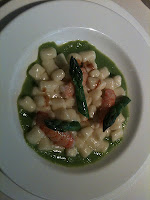 For the average British citizen, it's fun and games. For us, it's been work. A constant presence, an endless to do list, a cost, a stress point. That's not helped by living in what's probably the world's most cynical city, where news stories are more likely to be negative than to get the populace pumped up.
For the average British citizen, it's fun and games. For us, it's been work. A constant presence, an endless to do list, a cost, a stress point. That's not helped by living in what's probably the world's most cynical city, where news stories are more likely to be negative than to get the populace pumped up.My Olympic tedium started to shift about a fortnight ago. There was no denying it. As signs, facilities and lane closures started to go up in parts of town I traveled through (Waterloo, Horseguards, The Mall), I remembered that I was standing in what will, temporarily, be the centre of the world.
Then came the torch relay. The organising committee has been clever. The torch has zig-zagged across Britain in the run up to the games, with more than 8000 people doing a few hundred meters as official bearer. Some have been famous, but most are average citizens who've contributed to their community. And in that, they're not average at all.
My friend Sarah Crichton has been teaching disabled kids to swim for a decade. Giving up her Saturdays, week after week. Those precious Saturdays, so necessary for recharging batteries and getting the life admin done. Most of us sleep in or get our groceries. Sarah makes a difference.

Eight days before the games began, a group of friends drove to Kent to watch Sarah carry the torch into Canterbury. It was an odd mix of village fete and national news. Locals lined the streets, waving British flags and hoisting their children on their shoulders. A pub on the route was making the most of the opportunity, serving drinks out front and using a sound system to give the neighbours updates on the torch approach. Inside, TVs showed the local news' live coverage, talking about each bearer's merit as he or she took over. Sponsors helped turn it into a parade, with branded buses pumping music, filled with logo clad youngsters tossing free stuff to the crowd. Next, Olympic branded cars, then a bus carrying the other bearers, distinctively clad in white and gold, and then the phalanx of motorcycle police. And then, Sarah.
It was truly magical, though over in a minute. Fortunately, we had hours in the pub afterwards to relive the moment, examine the torch and celebrate our heroine. All eyes were on her and her torch, and we felt special being with her. That flame brought proper excitement to life.
A week later, I was in London. One day to go, and the place was in carnival mode. Familiar scenes like Horseguards and Lords had been transformed. Crowds on the streets made it feel like everyone was on holiday. Packs of fit young people in matching track suits were sightseeing, while to us, they were the sights. It was a different city.
By Friday night, cynicism was giving way to anticipation. And then the opening ceremony brought on the joy.
Film director Danny Boyle created a triumph, laced with self deprecating humour, music and contrast. Instead of trying to better the spectacle of Beijing, he went in a totally different direction. Small ... as these things go ... and quirky. It managed to be very, very British, without wallowing in stereotype. We cantered through history, children's literature and music, reminding the world of all the brilliant things that come from Britain. Famous faces turned up, and the Queen even chipped in by staring in a James Bond fantasy. I did worry that the whole thing was TOO British. We loved it, but wondered if much of the humour and many references would go right over the heads of viewers in other countries.
Even if it did misfire abroad, the ceremony worked a treat at home. Everyone here ... including the cynics, the bored, and the skeptical ... seems to have been transformed. The sun is shining. Life is good. And for the next little while, we're all going to enjoy being the centre of the universe.









